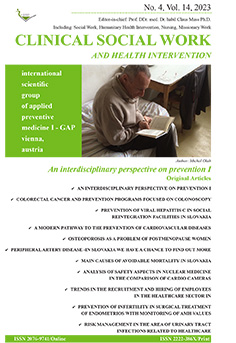Contributor´s Guidelines
Allow me to introduce a new expert journal – Clinical Social Work and Health Intervention. We would like to offer you an opportunity to contribute to its content as we would like to aspire to create a collection of real experiences of Social Workers, Doctors, Missionaries, Teachers, etc. CWS Journal is published by the International Scientific Group of Applied Preventive Medicine I-GAP in Vienna, Austria.
The journal is published quartely from the year 2016 and only in English language as it is published in various foreign countries.
We prefer to use the term ‘Clinical Social Work’ rather than Social work even though it is less common. In the profession of Clinical Social Work, there clearly is some tension coming from unclear definitions of competence of Social Workers and their role in the lives of theirs clients; the position of Social Work in the structures of scientific disciplines especially in cases where people declare themselves to be professionals even though they have no professional educational background. These are only few of the topics we like to discuss in the CWS Journal.
Payment information valid from 1 December 2019:
[/vc_column_text][vc_column_text]
Editorial plan for the year 2022:
Issue 1/2022: Impact of the Pandemic SARS-CoV-2
Issue 2/2022: Mental Health after the Pandemic
Issue 3/2022: The Pandemic in Developing Countries
Issue 4/2022: Marginalized Communitiesd
Editorial plan for the year 2023:
Issue 1/2023: Utilizing COVI-19 Vaccine Diplomacy
Issue 2/2023: Psychosocial Consequence of Armed Conflicts on Society
Issue 3/202: Social Work with Marginalized Roma Communities
Issue 4/2022: The Refugee Crisis in Europe
Your contribution should fit into the following structure:
- Editorial
- Review
- Original Article
- Letters
Instructions for contributors:
All articles must be in accordance with the current language standards in English, current ISO and the law on copyrights and rights related to copyrights.
Your contributions are to be sent via e-mail (addressed to: cswjournal@gmail.com) as an attachment or on a CD via regular postal service. In both cases written and saved in MS Word (no older version than year 2000).
Style Sheet Requirements:
Maximum length: 3,500 words
Letter type: Times New Roman
Letter size: 12
Lining: 1
All articles must include:
Name of the article and author’s address in English
Article abstract of 150 words in English
Brief professional CV of the author (100 words)
Publishing languages: English, German
Text of the article consisting of at most 3500 words
Article abstract should fit into the following structure:
- Objective
- Design
- Participants
- Methods
- Results
- Conclusion
Example of a Structured Abstract
Abstract:
OBJECTIVE: The aim of our research was to determine the effect of Speleotherapy on the quality of life, anxiety and depression in patients with COPD.
DESIGN: Pilot study.
PARTICIPANTS: The 128 patients with CPOD participated in the study (average age 64.05), examined during a spa treatment in a sanatoriums in the High Tatras. The experimental group (29 patients) completed spa treatment and Speleotherapy in the Belianska Cave. The control group (99 patients) completed a spa treatment without Speleotherapy. All patients were examined on admission and discharge, for an average 20-day treatment stay. Original Articles 8 Clinical social Work and Health Intervention Clinical Social Work and Health Intervention Vol. 7 No. 2 2016
METHODS: They were evaluated on the basis of the quality of life (SGRQ), Beck and Zung, the Spirometric Test (FEV1 and FEV1/FVC) and the 6-minute Walk Test.
RESULTS: After the treatment, concerning the patients of the experimental group we recorded that within the evaluation of quality of life there was significant improvement in symptoms (p<0.05). There was also statistically significant improvement in anxiety and the six-minute Walk Test (p<0.05).
CONCLUSION: The pilot study shows that spa treatment along with Speleotherapy improves the quality of life and anxiety in patients with COPD. However, there is a need for prolonged study with more patients in order to demonstrate the effectiveness of this therapy.
Each article must be an original never published before. When using references, parts of other articles or publications it is inevitable to quote them and provide information about the source.
We reserve the right to formally edit and reduce the text if needed. Academic articles undergo an anonymous critique. Each author will receive a prior statement of publishing his/her article. Reference styles writing: “name and year”.
When writing a review it is necessary to attach a copy of the cover of the book.
Published Statement of Human and Animal Rights
When reporting experiments on human subjects, authors should indicate whether the procedures followed were in accordance with the ethical standards of the responsible committee on human experimentation (institutional and national) and with the Helsinki Declaration of 1975, as revised in 2000 (5).
Published Statement of Informed Consent
Patients / clients have a right to privacy that should not be infringed without informed consent. Identifying information, including patients’ names, initials, or hospital numbers, should not be published in written descriptions, photographs, and pedigrees unless the information is essential for scientific purposes and the patient (or parent or guardian) gives written informed consent for publication. Informed consent for this purpose requires that a patient who is identifiable be shown the manuscript to be published. Authors should identify Individuals who provide writing assistance and disclose the funding source for this assistance.
Identifying details should be omitted if they are not essential. Complete anonymity is difficult to achieve, however, and informed consent should be obtained if there is any doubt. For example, masking the eye region in photographs of patients is inadequate protection of anonymity. If identifying characteristics are altered to protect anonymity, such as in genetic pedigrees, authors should provide assurance that alterations do not distort scientific meaning and editors should so note.
Published Conflict-of-Interest Statement
Public trust in the peer review process and the credibility of published articles depend in part on how well conflict of interest is handled during writing, peer review, and editorial decision making. Conflict of interest exists when an author (or the author’s institution), reviewer, or editor has financial or personal relationships that inappropriately influence (bias) his or her actions (such relationships are also known as dual commitments, competing interests, or competing loyalties). These relationships vary from those with negligible potential to those with great potential to influence judgment, and not all relationships represent true conflict of interest. The potential for conflict of interest can exist whether or not an individual believes that the relationship affects his or her scientific judgment. Financial relationships (such as employment, consultancies, stock ownership, honoraria, paid expert testimony) are the most easily identifiable conflicts of interest and the most likely to undermine the credibility of the journal, the authors, and of science itself. However, conflicts can occur for other reasons, such as personal relationships, academic competition, and intellectual passion.
Thank you for your cooperation
Yours sincerely,
Michael Olah
Editor CSW Journal
ISSN 2076-9741/ONLINE
ISSN 2222-386X/PRINT
Indexed by:


Scientific Partners




